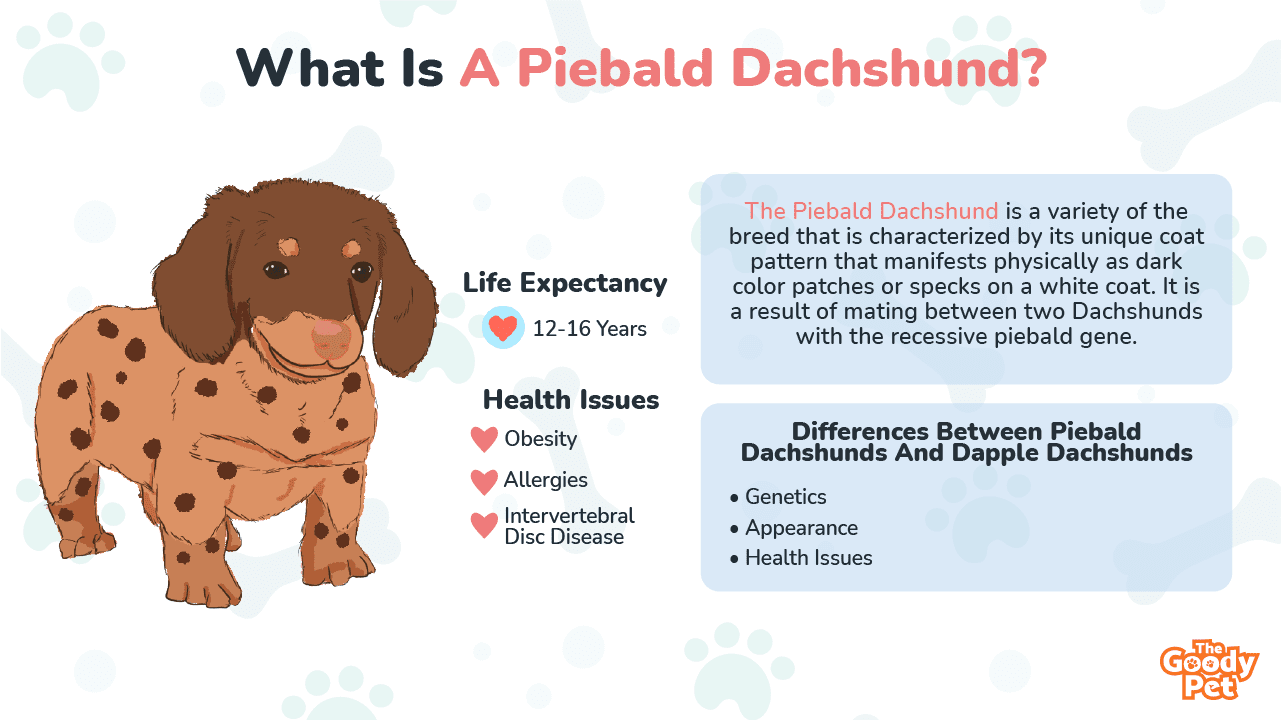I had believed for a long time that the Piebald Dachshund was nothing but another type of Dapple. So imagine my confusion and shock when I learned that they are quite different from each other. What exactly is a Piebald Dachshund, and what makes it different from other Doxies?
The Piebald Dachshund is a variety of the breed that is characterized by its unique coat pattern that manifests physically as dark color patches or specks on a white coat. It is a result of mating between two Dachshunds with the recessive Piebald gene.
The spots are usually of one color and can either be tan, brown, black, or even blue. The gene mutation on Piebalds is also associated with pigment-linked health issues.
Other than that, this dog is very similar to traditional Dachshunds in terms of personality, build, and so much more.
This intriguing work of biological art is a fun-loving family pet with a lot to offer. Let us dive into more information on what truly makes the Piebald Dachshund special so that you know what to expect if you are considering getting one.
Are Piebald Dachshunds Rare? What Do They Look Like?
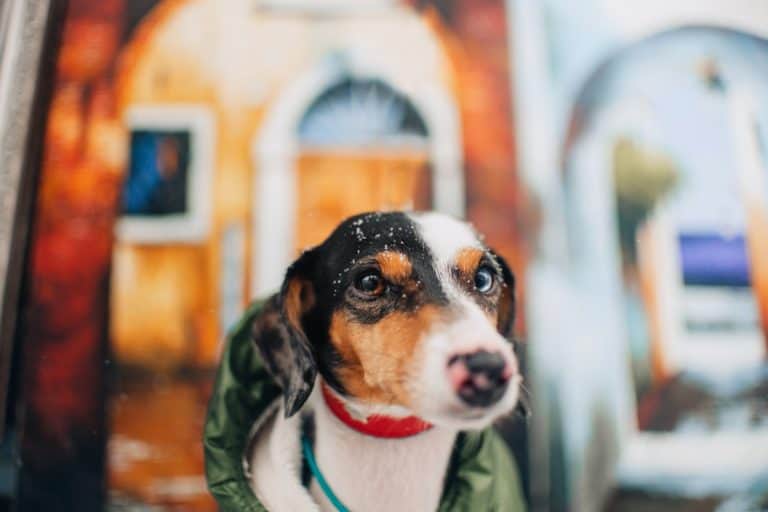
Piebald Dachshunds are quite common. This is mainly because of the transfer pattern of the gene responsible for the variation. When two Doxies with the gene mate, a majority of the puppies in the litter are born with the trait.
This is significant considering the average litter size of the breed, which lies between 4 to 8 pups each.
The most striking feature of Piebald Dachshunds is the coat pattern. They tend to have a white primary coat which is covered with spots of different colors including black, brown, and blue.
The size of these spots varies from large patches to small scattered speckles. Their distribution is also unique in that it tends to be random and asymmetrical.
The coat texture and appearance, on the other hand, varies from one Piebald weenie to another. It all depends on the coat type that the parent has.
As a result, you have three main options, which are the wiry, short, and smooth, and the long and smooth coat texture varieties.
When it comes to the body form, they are, in every way, typical Dachshunds. They have the iconic long and narrow torso and short and muscular legs.
They also grow to the same height and weight as their regular coat pattern counterparts. This, again, depends on the size of the parents.
Finally, the head and face also feature typical Doxie traits. The snout is long and narrow, with a wide and flat forehead at the end. The ears are also characteristically droopy and fall to the level of the jaw.
How Do You Get A Piebald Dachshund? Are They Purebred?
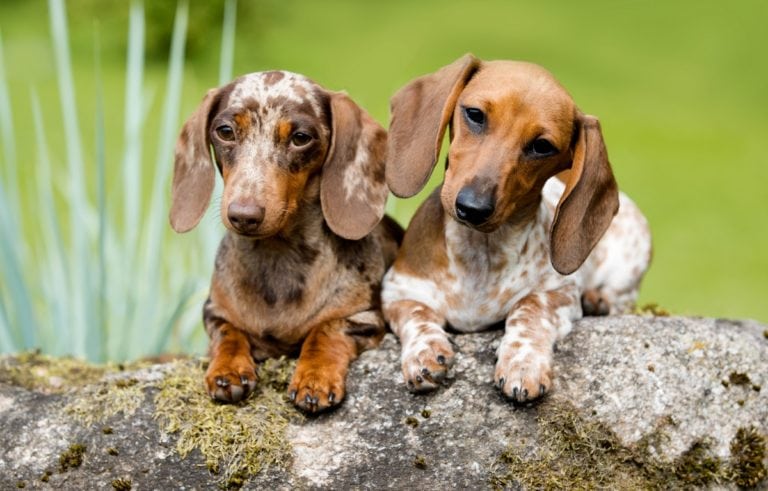
Piebald Dachshunds are considered by the American Kennel Club and other international regulators as purebred varieties.
This is because they are obtained from breeding two Dachshunds with the Piebald genes, with the Dachshunds themselves already enjoying the purebred status.
This decision affects a lot of things, ranging from health status to price.
Due to the availability of Piebald Dachshunds, you can pretty much find them anywhere. One option you have is to shop for them from breeders.
In this case, it is best to work with reputable businesses to ensure that you are getting a healthy puppy that was ethically bred.
You could also easily get one of these from a rescue shelter. The main perk of this option is that, more often than not, you will get the dog for free.
However, these Piebald weenies tend to be quite problematic, including issues like lack of domestication or an abundance of health issues that you will have to deal with after taking them home.
You could also get a Piebald Dachshund directly from dog owners whose pooches had Piebalds in their litter. This is another fantastic option if you want your doggy for free or at a bargain.
You can find such offers through ads- mainly online, whether it is on Facebook or dog owner forums.
In a nutshell, Piebald Dachshunds are generally very easy to find. It just depends on how much you want to spend and how healthy you want the pooch you take home to be.
Why Is It Called Piebald And What Causes It?
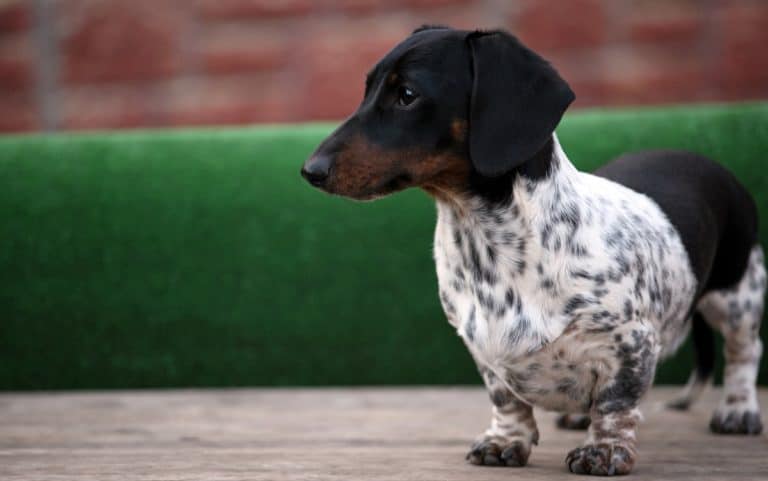
The term Piebald is used in animal breeding to describe a coat pattern with a combination of white and dark spots.
Being Piebald in dogs means that the animal has dark patches on a white or cream coat base. The specks appear randomly throughout the body and tend to be asymmetrical.
When defining a Piebald, according to the American Kennel Club, it takes only one dark spot on white fur on a Dachshund to qualify the dog as part of this coat pattern variation.
This coat pattern, contrary to popular belief, is not a part of the Dapple group caused by the Merle gene.
It is instead a result of the presence of a mutation referred to as the Piebald gene.
This affects pigment cells and results in abnormal hyperpigmentation spots all over the body. The gene itself exists in different varieties.
These determine everything from the size of the patches and the color to their distribution patterns. When it comes to distribution, there are three main options namely the Tuxedo, Plated, and Extreme Piebald.
The Tuxedo Piebald has the least amount of white coat visible. The Plated has about 50% of the body covered with dark patches while the Extreme Piebald is characterized by few dark patches leaving about 80% of the coat all white.
Of note with the Piebald gene is the fact that it is recessive. This means that both parents either have to be Piebalds or, at the very least carriers, to produce Piebald Dachshund pups.
Do Piebald Dachshunds Have Health Issues?
Piebald Doxies are generally healthy dogs. This is because, unlike the Merle gene in Dapples, the Piebald gene is not particularly prone to ailments.
However, it is associated with pigment-linked hearing issues. The most common here is congenital deafness in which case the Piebald pups are born with the impairment.
If your Piebald pooch has this problem, definitely consider getting them the FunDog Bandana For Deaf Dogs.
This cute little accessory has the text “I’m not ignoring you! I’m deaf,” which is not only adorable but also functional for when you go out together.
If the Piebald is mixed with a Dapple Dachshund, then this is where things get problematic.
This is commonly associated with vision problems. It could be anything from partial blindness to the dog being born without one or both eyes.
Whatever the case, it is completely inconvenient for the pooch and reduces their quality of life.
Blind and deaf Piebald weenies regularly get lost due to their limited situational and environmental awareness.
You could make your life a whole lot easier and less stressful but just investing in a tracker.
The PetFon Pet GPS Tracker is a fantastic alternative in this case. It uses both Wi-Fi and Bluetooth for wide and clear coverage. It offers a sensitivity range of 0.65 miles in dense spaces like cities and 3.5 miles range in open spaces.
In addition to these sensory issues, Piebald Dachshunds suffer from diseases common to regular Doxies. These include obesity, back and general joint issues like intervertebral disc disease (IVDD), as well as allergies.
Piebald Dachshund VS Dapple Dachshund: Learning To Differentiate
Throughout this in-depth review of Piebalds, we have drawn a lot of comparisons to Dapple Dachshunds, and with good reasons.
Many of us easily get the two confused as they are both considered anomalies in coat patterns in the weenie breed.
However, these two are quite different with different genetic bases, appearances, and associated problems.
Genetics
Dapple Dachshunds are a result of the presence of the Merle gene. This affects not only the coat pattern but also things like eye and ear development and function.
The Piebald Doxie, on the other hand, is a result of the Piebald gene. For the most part, this only affects the coat pattern.
Passing Down Of Genes
The merle gene responsible for Dapple Dachshunds is a dominant variant. This means that it is only needed in one parent to manifest in the pup.
On a side note, it is absolutely discouraged to breed 2 Dapple Dachshunds as the resulting offsprings will tend to have many health problems. Read more about Double Dachshunds and their curse right here.
The Piebald gene, on the other hand, is a recessive one.
In this case, both parents either have to be affected by the anomaly or carriers of the variant for puppies to have the pattern.
Appearance
The Piebald has a characteristic combination of a white coat base with dark spots that could either be brown, black, or blue.
The Dapple, on the other hand, manifests in a wide variety of coat patterns combining different colors. It could be anything from a Black and Tan Dapple to the rare red pattern.
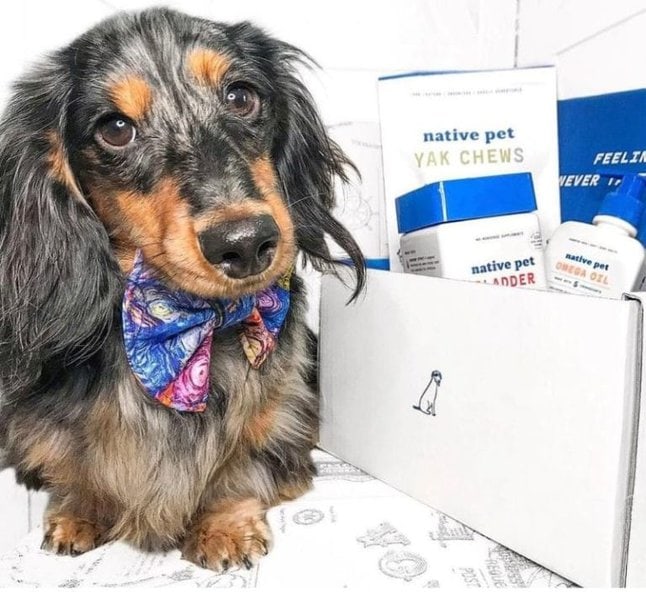
Health Issues
Finally, these two differ in terms of health consequences. The Piebald is a relatively low-risk mutation as far as health issues are concerned and have only been loosely linked to hearing problems.
The Merle gene, on the other hand, is associated with a variety of problems, including deafness, blindness, and bone and joint issues.
Related Questions
What Is A Tuxedo Piebald Dachshund? This is a type of Piebald Dachshund characterized by the amount of white fur left untouched by the dark patches. It has the least coverage of white fur of the three varieties of Piebalds. The white fur here characteristically appears on the chest, all four legs, the tip of the tail, and sometimes on the face.
How Much Does A Piebald Dachshund Cost? Piebald Doxies are relatively easy to find and are therefore not very expensive. In fact, they can cost as low as $200 or even free if you adopt from a shelter. However, with high-quality bloodlines from professional breeders, you may have to pay more, with prices ranging from $1,000 to $1,500.
What’s The Difference Between Piebald And Skewbald? The Skewbald is a type of coat pattern where the base coat is dark and littered with white patches in random patterns. The dark base is usually brown, and if black, the dog does not qualify as a Skewbald. The Piebald, on the other hand, has a white base and dark spots that may be Black, Brown, or other Dark Doxie coat colors.

